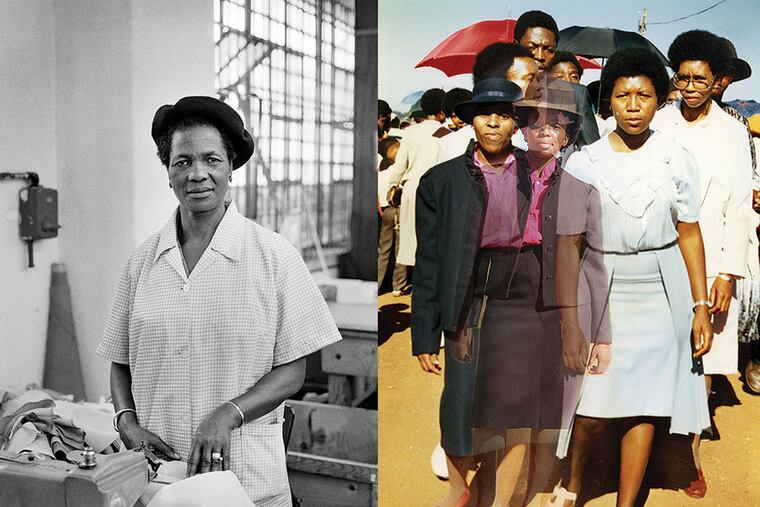A global reckoning with racial injustice at the Barnes Foundation
"Tell Me What You Remember" features a wide range of media — from oral history to sculptures to textiles — created by two South African artists, Sue Williamson and Lebohang Kganye.

In a viewing room of the Barnes Foundation, glittering travel brochures line the wall. A whitewashed clapboard house, cast against a cloudless blue sky, promises days of idyl. Another image shows the pristine interior of a church, empty of people.
But viewed from the other side, these pictures tell a different story: that of Matthew Goniwe, a beloved community member and anti-apartheid activist abducted and brutally murdered by state security forces.
In A Tale of Two Cradocks (1994), artist Sue Williamson has cleverly arranged a series of panels to double as segregationist propaganda and a measured account of injustice. Williamson grants us the discretion — and the moral responsibility — of choosing what to see.
This work sets the tone for the rest of the exhibition, which unites two South African artists in a cross-generational dialogue. In a series of works by turns devastating and optimistic, “Sue Williamson & Lebohang Kganye: Tell Me What You Remember” stages a complex reckoning with apartheid.
Though the exhibition features a wide range of media — from sculptures to textiles — the focus remains on oral history, a favorite medium of both artists.
Williamson, one of South Africa’s most prominent artists, made her bones campaigning against apartheid in the 1970s and ‘80s. Even today, her activism remains inextricable from her creative practice.
In the photo series Truth Games (1998), she inspects some of the most high-profile cases of the Truth and Reconciliation Commission, the justice body formed in South Africa to examine human rights violations after apartheid. Each piece groups together the piecemeal testimonies of victims and perpetrators, written on overlapping plastic slats.
The inscriptions — one chillingly reads “was everything to me” — can easily be erased by sliding the panel a few inches to the left or right, concealing the narrative. Truth Games gains much of its emotional bite from this built-in potential for elision and omission.
In contrast to Williamson, Lebohang Kganye, whose work was a part of the latest Venice Biennale, is of an altogether different generation. Born in 1990, Kganye belongs to the cohort controversially dubbed born-free: those who came of age after the dismantling of apartheid. Yet her work is infused with the same historical awareness, and remains equally penetrating.
Kganye’s artistic practice centers on memory, with equal regard for sweeping national histories and intimate kitchen-counter exchanges. Family storytelling is at the heart of her work, most notably in Mohlokomedi wa Tora (2018). This ambitious installation features a rotating light tower calibrated to illuminate large-scale cutouts of family photos. Kganye has managed to unite all her ancestral sources — forcibly dispersed under colonial and apartheid rule — under the warm, healing glow of a homespun lighthouse.
Though Williamson and Kganye use different tacks to convey the horrors of apartheid, “Tell Me What You Remember” highlights the concord between the two artists. Both technical and thematic affinities abound, as Kganye’s matrilineal grisaille portraits echo Williamson’s black-and-white photos of the female leaders of the apartheid struggle.
Both artists conjure the dead. In Last Supper at Manley Villa (1981, 2008), Williamson frames an erstwhile neighborhood — demolished in an act of ethnic cleansing — next to the vacant site of its demolition. Meanwhile, the artist supplants the deceased in Kganye’s eerie photo reenactments of her mother. Both artists seem to ask whether memory carries the burden of falsification — if dredging up the ghostly past amounts to fabulation.
Though these women’s voices are rooted in South Africa, the narratives they uncover are of equal relevance an ocean away. As Kganye tells me, “these are global politics and global issues” that find acute resonance with our homegrown discussions about Black family identity.
The choice to platform Williamson and Kganye bodes well for the Barnes Foundation’s future.
With one foot firmly in the past, the Barnes is in a bind over the pressure to seesaw between its core collection of impressionist masterworks and an institutional interest in accommodating a diverse public. And though the Barnes has a strong history of community outreach and involvement, the threat of a disinterested public continues to weigh.
“Sue Williamson & Lebohang Kganye: Tell Me What You Remember” is open at the Barnes Foundation from March 5 2023 to May 21. https://www.barnesfoundation.org/williamson-kganye